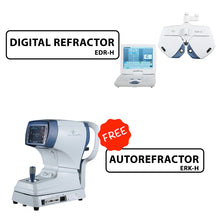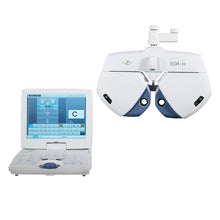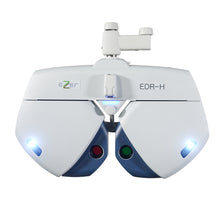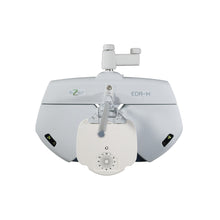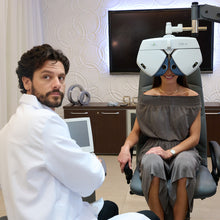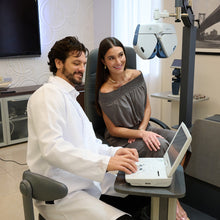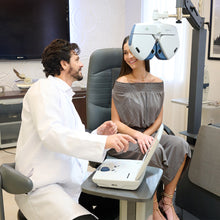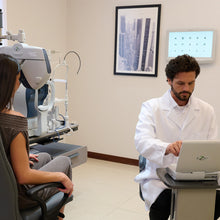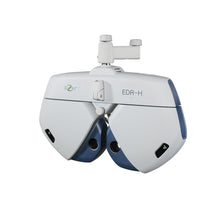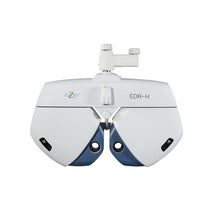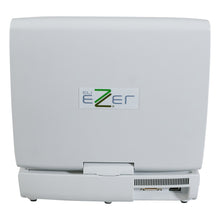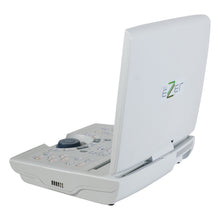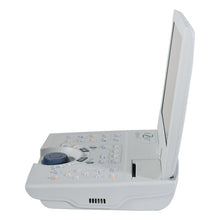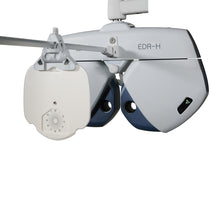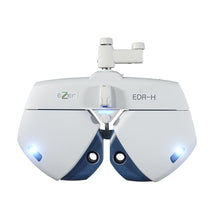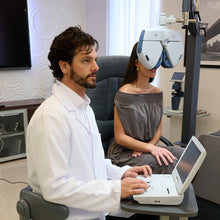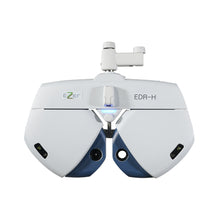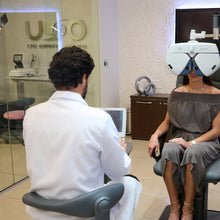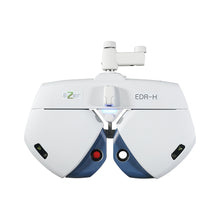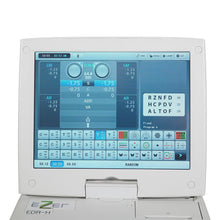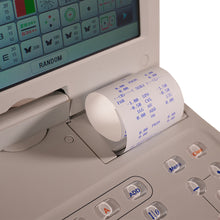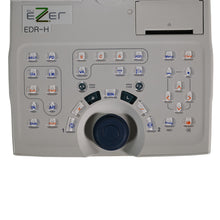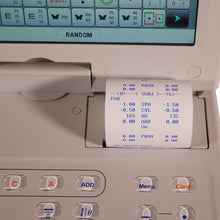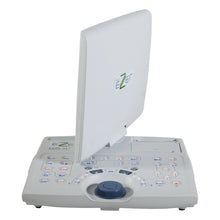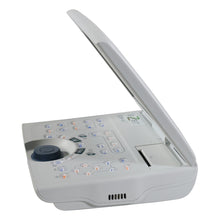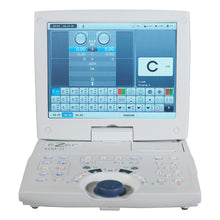Ezer Digital Refractor EDR-H
Buy the Digital Refractor EDR-H
Get a FREE Autorefractor ERK-H
The Ezer EDR-H Digital Refractor has been redesigned for a smaller and slimmer look. The placement of the tactical buttons along with the touch screen interface makes the EDR-H easy to use. Increase your efficiency with features like the dual cross cylinder test, programmable exam sequences and wireless connection with other pre-testing equipment.
The EDR-H Digital Refractor by Ezer brings cutting-edge technology, modern design, and precision optics to the exam room, making ophthalmic exams effortless.

Dual Cross Cylinder Lens
A new and improved method to refine the cylinder axis and power using the Dual Cross Cylinder Lens. This allows the patient to see a split/dual image of the test object so they can easily discern which image is more visually appealing. This feature reduces patient confusion and speeds up the refraction process. Cross cylinder examination is more precise and effective for astigmatism exams as the doctor can adjust the axis incremental change for higher cylindrical powers. The spherical equivalent can also be adjusted automatically.

Ergonomic Design
Measuring a patient’s refractive index and eyeglass prescription is painless with the EDR-H. The EDR-H is designed to perform all kinds of tests for astigmatism, spherical refinement, binocular vision, and more. The carefully crafted lenses within this digital refractor provide a wide dioptric range (-29D to +26.75D) providing accurate measurements regardless of myopic severity. Due to the wide viewing angle of 40 degrees, the test results can be accurately secured.
Advanced Engineering
The step motors operate at fast speeds, ensuring that the lenses are placed properly for the patient, reducing patient confusion and significantly speeding up the exam process.
Thanks to Ezer’s engineering expertise, all of the adjustments that need to be done by the refractor during and between tests are handled by the headset’s quiet internal mechanisms.

Visual Charts and Tests
The EDR-H offers worldwide standardized charting. With a built-in System Program, Custom Programs and Unit Test Functions, the possibilities are endless. Practitioners can completely control the exam according to their own professional preference.

Near Eye Chart
The Vision Test function makes it is easy to help patients understand the differences between various refractive errors and diseases. The near visual acuity test can be done with the near eye chart and auxiliary eye chart. These eye charts can be selected depending on user’s taste and the testing goals.

Closed Optical System
The EDR-H has been designed with an enclosed optical system. This minimizes the chances of a patient's ocular fluids contaminating the internal lenses.
Forehead Sensor
The Forehead location detector is equipped with alert features to indicate each patient's optimum face location for testing. This system can also check to ensure that patients are maintaining correct postural positioning during each test.

Large Screen and Convenient Touch Screen Display
Most of the interface is controlled by the touchscreen, with only a few physical buttons on the base of the equipment to control the most essential features. As the diagnoses progresses, figures are expressed on an 10.4 inch wide screen with intuitive interface with various colors. The display setup is easy to understand, making the practitioner aware of the testing content. By adopting a touch-screen interface, optometrists can use the most advanced technology, even if they are not fully familiar with this progressive technology.

Provide Tilting & Swivel Monitor
Regardless of the position of the patient or the optometrist, the screen can be rotated to any angle or direction.

A large central dial allows users to change measurement values with a pleasing tactile sensation reminiscent of manual instruments, enhancing the user experience. The click function provides lens conversions and program executions in a much faster and convenient manner. The new and improved key design is arranged by function and has good touch sensitivity and improved durability.

Built In Printer
All exam data is automatically stored on the control box and can be quickly pulled up by the user at any time. The control box also has a built-in printer to easily produce a hard copy of test results on-demand. Furthermore, the control box comes loaded with several easily digestible patient education slides — just tilt and swivel the screen towards the patient to get them engaged in their eye care.
Compatible Connection with Various Systems
The EDR-H can connect to several other digital ophthalmic instruments by Ezer to serve as the hub of the digitally-enabled exam room. Data can be entered or transferred directly from compatible devices, and the control box can operate many of the different functions of each device.


Wireless Networking (optional)
EDR-BH can be connected to ERK-BH, EDC-BH and ELM-BH via WIFI.
DIGITAL CLINIC

What is an EMR?
Electronic Medical Records, commonly abbreviated as “EMR”, are a technological tool used widely in modern medical practices. EMR systems were designed to replace outdated paper charting methods and streamline the collection and tracking of patient data over time. EMR platforms integrate the various components of a doctor’s office visit, including intake demographics and medical history, prescription information, laboratory data, practice management software, exam notes, and more.
Overall, EMR systems are used to promote economic efficiency and improved patient care through a seamless coordination of data collection and storage. EMR platforms also increase patient transparency through use of portals where patients can view important results and communicate with Doctor’s in a secure manner.

In the Ophthalmic industry, EMR are becoming more important and popular than ever. The ability to save critical lab data relating to prescriptions and diagnoses while maintaining quick access to that information is key in decreasing chair time and improving patient outcomes and satisfaction.
With the Ezer Digital Practice, information sharing is easier than ever! The ELM-BH Lensometer, ERK-H/BH Autorefractor, EDR-H Phoropter, and EDC-BH Visual Acuity Chart all interact via Wifi to streamline communication between your pretest and exam rooms.
We know it can be scary to introduce a new technology to your practice, but with the Ezer Digital Practice equipment and US Ophthalmic’s superior tech support, your practice will save time and money with a seamless EMR integration.
| Our EMR Partners |

|

|
Easy Maintenance and Upgrade
The forehead pedestal, facial contact piece, and eyepiece protective lens are designed to be detachable for easy removal and cleaning. This allows practitioners to maintain a hygienic test environment. Additional, the system software can be upgraded easily through the USB interface.
EDR-H provides ophthalmic practices with a unified experience and a fluent data platform. This instrument will provide a new level of synergy to your practice, benefiting patients, clinicians, and technicians alike.
EDR-H Video
Digital Practice

Click here to see the manual
| Sphere Power(SPH) | |
| Measurement Range |
-29.00 ~ +26.75D(general) -19.00 ~ +16.75D(cross cylinder or prism) |
| Measurement Unit | 0.12D/0.25D/0.50D/1.00D |
| Cylinder Power(CYL) | |
| Measurement Range | 0D ~ ±8.75D |
| Measurement Unit | 0.25D/1D/2D/3D |
| Axis(AX) | |
| Measurement Range | 0°~180° |
| Measurement Unit | 1°/5°/15° |
| Interpupillary Distance | |
| Measurement Range | 1.9 ~ 3.15in, measurement distance, 13.8 ~ 27.6 (48 ~ 80mm, measurement distance, 350 ~ 700mm) |
| Measurement Unit | 0.02/0.04in (0.5mm/1mm) |
| Prism Degree | |
| Measurement Range | 0△~20△ |
| Measurement Unit | 0.1△/0.5△/2△ |
| Prism Angle | |
| Measurement Range | 0°~360° |
| Measurement Unit | 1°/5° |
| Cross Cylinder |
Automatic Cross Cylinder(±0.25D) 0.25D ± cross cylinder 0.50D ± cross cylinder |
| Subsidiary Lens |
P.D/cover/pin hole(? 2mm)/(polarized light filter(45°/135°) madox road(right eye: horizontality, left eye: verticality) red-green filter(right eye: red filter, left eye: green filter) polarized light filter(right eye: 135°, 45°)(left eye: 45°, 135°) seperation prizm(right eye: 6△BU, left eye: 10△BU) |
| Size |
Refractor:12.8-15.3(W)x9.6(D)x2.32(H)in/8.14lb (323-389(W)x245(D)x59(H)mm/ 3.7kg) Controller: 10.23(W)x9.05(D)x2.3(H)in/6.82lb (printer included) (260(W)x230(D)x58(H)mm/ 3.1kg(printer included)) Junction Box: 8.3(W)x7.5(D)x2.8(H)in/ 4.62lb(printer included) (210(W)x190(D)x70(H)mm/ 2,1kg(printer included)) |
| Sphere Power(SPH) | |
| Measurement Range |
-29.00 ~ +26.75D(general) -19.00 ~ +16.75D(cross cylinder or prism) |
| Measurement Unit | 0.12D/0.25D/0.50D/1.00D |
| Cylinder Power(CYL) | |
| Measurement Range | 0D ~ ±8.75D |
| Measurement Unit | 0.25D/1D/2D/3D |
| Axis(AX) | |
| Measurement Range | 0°~180° |
| Measurement Unit | 1°/5°/15° |
| Interpupillary Distance | |
| Measurement Range | 1.9 ~ 3.15in, measurement distance, 13.8 ~ 27.6 (48 ~ 80mm, measurement distance, 350 ~ 700mm) |
| Measurement Unit | 0.02/0.04in (0.5mm/1mm) |
| Prism Degree | |
| Measurement Range | 0△~20△ |
| Measurement Unit | 0.1△/0.5△/2△ |
| Prism Angle | |
| Measurement Range | 0°~360° |
| Measurement Unit | 1°/5° |
| Cross Cylinder |
Automatic Cross Cylinder(±0.25D) 0.25D ± cross cylinder 0.50D ± cross cylinder |
| Subsidiary Lens |
P.D/cover/pin hole(? 2mm)/(polarized light filter(45°/135°) madox road(right eye: horizontality, left eye: verticality) red-green filter(right eye: red filter, left eye: green filter) polarized light filter(right eye: 135°, 45°)(left eye: 45°, 135°) seperation prizm(right eye: 6△BU, left eye: 10△BU) |
| Size |
Refractor:12.8-15.3(W)x9.6(D)x2.32(H)in/8.14lb (323-389(W)x245(D)x59(H)mm/ 3.7kg) Controller: 10.23(W)x9.05(D)x2.3(H)in/6.82lb (printer included) (260(W)x230(D)x58(H)mm/ 3.1kg(printer included)) Junction Box: 8.3(W)x7.5(D)x2.8(H)in/ 4.62lb(printer included) (210(W)x190(D)x70(H)mm/ 2,1kg(printer included)) |
EDR-H Digital Phoropter
Dr Petito talks about the EDR-H
EDR-H - Benefits of Digital Refraction
EDR-H - Comparing Prescriptions
EDR-H - Step 1: Setting Up
EDR-H - Step 2: Taking Acuity
EDR-H - Step 3: Subjective Refraction
EDR-H - Step 4: Compare Prescriptions
EDR-H - Step 5: Phoria Testing
EDR-H - Step 6: Jackson Cross Cylinder
EDR-H - Step 7: Testing for ADD
Digital Practice












































